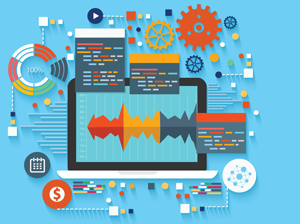Summary: Gartner recommends that data and analytics leaders talk with senior business leaders about their critical business priorities and explore how the following top trends can enable them.

“The story of data and analytics keeps evolving, from supporting internal decision making to continuous intelligence, information products and appointing chief data officers,” she said. “It’s critical to gain a deeper understanding of the technology trends fueling that evolving story and prioritize them based on business value.”
Gartner recommends that data and analytics leaders talk with senior business leaders about their critical business priorities and explore how the following top trends can enable them.
No. 1: Augmented Analytics
Augmented analytics is the next wave of disruption in the data and analytics market. It uses machine learning (ML) and AI techniques to transform how analytics content is developed, consumed and shared.
No. 2: Augmented Data Management
Augmented data management leverages ML capabilities and AI engines to make enterprise information management categories including data quality, metadata management, master data management, data integration as well as database management systems (DBMSs) self-configuring and self-tuning. It is automating many of the manual tasks and allows less technically skilled users to be more autonomous using data. It also allows highly skilled technical resources to focus on higher value tasks.
No. 3: Continuous Intelligence
Continuous intelligence is a design pattern in which real-time analytics are integrated within a business operation, processing current and historical data to prescribe actions in response to events. It provides decision automation or decision support. Continuous intelligence leverages multiple technologies such as augmented analytics, event stream processing, optimization, business rule management and ML.
No. 4: Explainable AI
AI models are increasingly deployed to augment and replace human decision making. However, in some scenarios, businesses must justify how these models arrive at their decisions. To build trust with users and stakeholders, application leaders must make these models more interpretable and explainable.
No. 5: Graph
Graph analytics is a set of analytic techniques that allows for the exploration of relationships between entities of interest such as organizations, people and transactions.
No. 6: Data Fabric
Data fabric enables frictionless access and sharing of data in a distributed data environment. It enables a single and consistent data management framework, which allows seamless data access and processing by design across otherwise siloed storage.
No. 7: NLP/ Conversational Analytics
The need to analyze complex combinations of data and to make analytics accessible to everyone in the organization will drive broader adoption, allowing analytics tools to be as easy as a search interface or a conversation with a virtual assistant.
No. 8: Commercial AI and ML
Commercial vendors have now built connectors into the Open Source ecosystem and they provide the enterprise features necessary to scale and democratize AI and ML, such as project & model management, reuse, transparency, data lineage, and platform cohesiveness and integration that Open Source technologies lack.
No. 9: Blockchain
The core value proposition of blockchain, and distributed ledger technologies, is providing decentralized trust across a network of untrusted participants. The potential ramifications for analytics use cases are significant, especially those leveraging participant relationships and interactions.
No. 10: Persistent Memory Servers
New persistent-memory technologies will help reduce costs and complexity of adopting in-memory computing (IMC)-enabled architectures. Persistent memory represents a new memory tier between DRAM and NAND flash memory that can provide cost-effective mass memory for high-performance workloads. It has the potential to improve application performance, availability, boot times, clustering methods and security practices, while keeping costs under control. It will also help organizations reduce the complexity of their application and data architectures by decreasing the need for data duplication.
Click this link for more details: Gartner
若喜歡本文,請關注我們的臉書 Please Like our Facebook Page: Big Data In Finance


留下你的回應
以訪客張貼回應